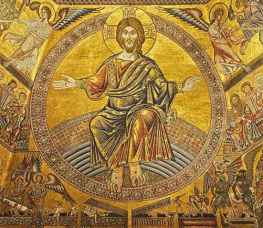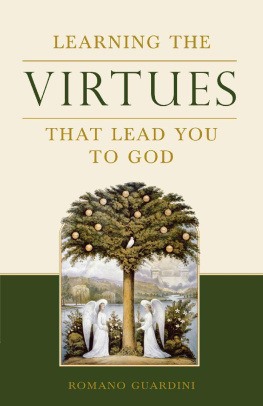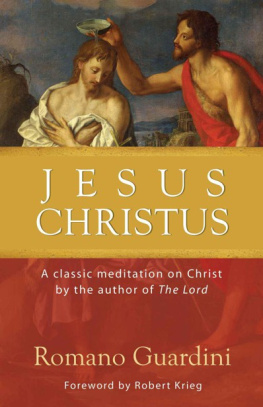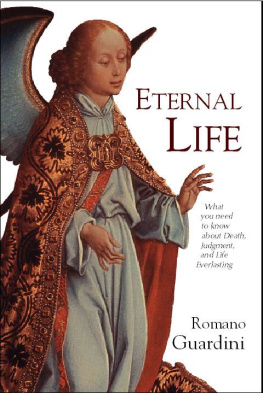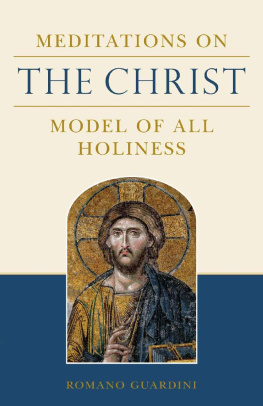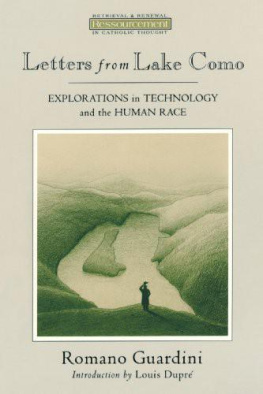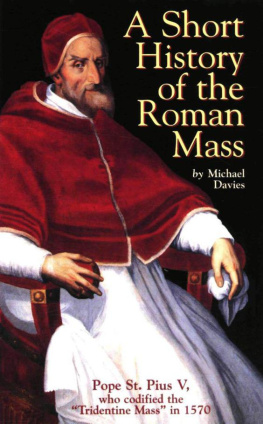Like fine wines, some books get better as they age. Placed alongside the reformed Eucharistic liturgy of Vatican II, this veritable classic will continue to instruct, inspire, and enrich present and future generations of Catholics for whom the liturgy is the summit and source of our lives.
Msgr. Kevin Irwin
Walter J. Schmitz Chair of Liturgical Studies
The Catholic University of America
With these meditations you can sense the active participation of the people already coming to birth in the 1950s. Guardini promotes not just a renewed liturgy but a renewed people.
Rev. Paul Turner
Author of At the Supper of the Lamb
First published in English in 1956 by Newman Press. Translated from the original German Besinnung vor der Feier der Heiligen Messe , Mainz: Matthias-Grunewald-Verlag, 1936, by Elinor Castendyk Briefs.
Acknowledgments from the original:
We wish to thank the Apostolat Liturgique of Belgium and the E. M. Lohman Company of Saint Paul, Minnesota, for permission to quote copyrighted material from the Saint Andrew Daily Missal . All quotations from the New Testament are taken from the Confraternity of Christian Doctrine edition, 1947; quotations from the Old Testament are from the Douay Version.
___________________________________
Foreword 2014 by Eugene F. Hemrick
All rights reserved. No part of this book may be used or reproduced in any manner whatsoever except in the case of reprints in the context of reviews, without written permission from Christian Classics, Ave Maria Press, Inc., P.O. Box 428, Notre Dame, IN 46556, 1-800-282-1865.
Founded in 1865, Ave Maria Press is a ministry of the United States Province of Holy Cross.
www.christian-classics.com
Paperback ISBN-13 978-0-87061-285-5
E-book ISBN-13 978-0-87061-286-2
Cover image SuperStock.
Cover and text design by David Scholtes.
Printed and bound in the United States of America.
Library of Congress Cataloging-in-Publication Data
Guardini, Romano, 1885-1968.
[Besinnung vor der Feier der Heiligen Messe. English]
Meditations before mass / Msgr. Romano Guardini; translated from the German by Elinor Castendyk Briefs.
pages cm
Originally published: Westminster, Md. : Newman Press, 1956.
Includes bibliographical references.
Summary: Exemplifies a wise, pastoral, and timeless classic on preparing oneself for Mass-- Provided by publisher.
ISBN 0-87061-285-9 (978-0-87061-285-5)
1. Mass--Meditations. I. Title.
BX2169.G8313 2014
264.02036--dc23
2013044593
for
Lene and Hans Waltmann
Contents
Foreword
by Eugene F. Hemrick
E very so often I meet parishioners while visiting the Smithsonians Air and Space Museum on the mall here in Washington, DC. I ran into Senator Patrick Leahy on one such occasion. He occasionally attends Mass where I serve. Father, what brings you to the museum? he asked. I often walk the mall to collect my thoughts for the Sunday homily and then grab lunch here, I answered. Senator Leahy replied in turn, You know, I leave my office in the US Capitol and do the very same thing when trying to sort through a tough issue.
Another example of the power of contemplation or meditation comes from the Supreme Court building that is just a quarter of a mile from the Air and Space Museum. While ascending its steps, one is met by the statue of a woman seemingly in pain. Her head is bowed and she looks very serious. As she leans against a book of laws, she cradles a child who is holding a balancing scale. This statue, The Contemplation of Justice, with her serious demeanor and bowed head, communicates a great deal about the effort required for making right judgments.
Undoubtedly embracing meditation while composing a thoughtful homily, sorting out knotty governmental issues, or achieving true justice heightens the probability of success, but more vital than these is our need to embrace meditation as the ultimate means of drawing close to Christ.
In Meditations Before Mass, the great twentieth-century priest and theologian Romano Guardini invites us to explore the spiritual and life-giving powers of meditation and to utilize its qualities of stillness, silence, and composure for plummeting the awe-inspiring mysteries that the Mass and its holy environment possess. He reminds us that proper preparednessin the form of quietness, reflectiveness, and inwardnessis at the heart of drinking in the fullness of the Mass.
As a priest of fifty years, I confess it is easy to fall into mere routineto have been there, done it, seen it, and to be less than energetic in pursuing deeper insights into the Mass and its hallowed environment. Thanks to a friend who gave me an old copy of Meditations Before Mass I now have a wonderful companion for growing in awe of the Mass. Each time I read it I have a new a-ha experience. These remind me that the church environment in which I celebrate Mass every day isnt an old, familiar, taken-for-granted structure but a revered holy temple filled with profoundly inspiring symbols. I am reminded that the altar is more than a beautifully carved slab of marbleit is a mystical table possessing sacred meanings. And, I am reminded that the familiar words of the Mass, which can become little more than mechanical repetition, possess endless wisdom.
Once when searching for deeper meaning in a homily on the topic of the Mass, I turned to Guardinis chapter The Memorial. In it he writes,
What is repeatedly executed and invoked in [Do this in memory of me] is no natural or intellectual or mysterious power-relationship common to all human existence, but the memory of One who lived once, and of His destiny. Why? Not because He was a great ruler or lawgiver or warrior from the worldly point of view, an innovator of important arts or sciences, but because His life and work are decisive for mens salvation, because He is the Savior.
How easy it is for us to hear, Do this in memory of me and then to move on in the Mass. Guardini, however, encourages us to pause and drink in the realization that here is our salvation, the ultimate means of being with God for eternity.
In the opening chapters of this book, Romano Guardini inspires to us go inward, employ stillness, seek composure and be all there when preparing for the Mass. Although his chapters on stillness, silence, hearing, and composure were written in the 1950s when life was a little less complicated, they are classicspeaking to our times and times to follow. He writes,
As a rule a mans attention is broken into a thousand fragments by the variety of things and persons about him. His mind is restless; his feelings seek objects for one thing after another; his will is captured by a thousand intentions, often conflicting. Composure works in the opposite direction, rescuing mans attention from the sundry objects holding it captive and restoring unity to the spirit. It frees his mind from its many tempting claims and focuses it on one, the all-important. It calls the soul that is dispersed over myriad thoughts and desires, plans and intentions back to itself, re-establishing its depth.
We are told that before Christ chose his apostles he went off to a mountain and prayed all night, taking the time necessary to compose himself before making his choices. Guardinis chapter on composure causes us to wonder how much more peaceful and orderly our life would be if we embrace the composure Christ practiced and strive to re-establish the depth of our soul.


